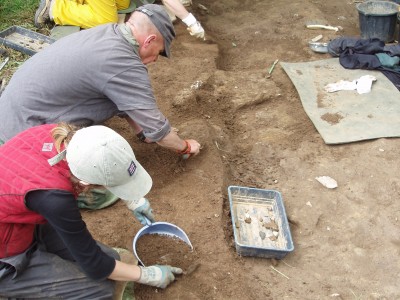
7th 11th June 2009
I was very excited to be allowed to join experimental archaeologist Jacqui Wood at her home in Saveock Water near Truro ( Cornwall) to excavate part of her smallholding. Over the years along with many volunteers and students she has uncovered a significant portion of this vast site. The site has exciting finds 'from post holes to lego' laid down from the mesolithic period to only yesterday.
During our M.A year Claire Long and I came across Jacqui's book "Prehistoric Cooking" almost a year too late to help us with our Prehistoric food ecologies experiments but interesting nevertheless. Sadly even though we saw her website we never got to visit Jacqui as we were up to our eyeballs in acorns, cheese and bog butter. Though Claire didn't get to join her in the current season I am sure that the two will meet in subsequent years.
Jacqui is famous for making the " iceman's "boots, his deerskin coat and grass cape and notably for her replica of the iron age" Orkney hood". She is a really talented person who has been in the vanguard of experimental archaeology now for years. An important part of her process is to makes replica "finds" and experiment with them to see how they were made, how they function and allow " things themselves" to how give rich insight into prehistoric minds.
Over the 5 day course we were instructed in the core techniques of scraping, potwashing, flicking and planning. Mark and I who are total novices were allowed to " dig" alongside more experienced participants at the dig. The weather was on our side so we were able to excavate a newly uncovered Mesolithic platform along with Cathy from St Marys, Ontario, Dave from Bude, Stella from Penwith, Linnea and Harriet . When I uncovered a yellow crust of sand Jacqui told us this was the remains of the hearth and meant that it was probably a riversied dwelling. The post holes confirmed that this had been a bender type dwelling with a packed clay floor.
We were also blown away by the Aurock, giant deer and tiny horse footprints that Jacqui showed us on this mesolithic clay layer.
Neolithic votive pools, bronze age roundhouses, cracked boulder workings and evidence of tin working are just some of the different things that have been uncovered and there is much much more to find.
I am already doing a little experimentation of my own having been told that moss was used as a haft for stone tools.
Seaweed is indeed a good setting for flint and can be used successfully as a haft. I picked up kelp on the beach at Downderry this weekend and hope to experiment more with this process. The kelp stem is slit and the blade inserted. As the kelp dries the tool is held tightly in place.
For more information visit http://web.me.com/a.keleher/Site/Making_Stuff_pics.html

